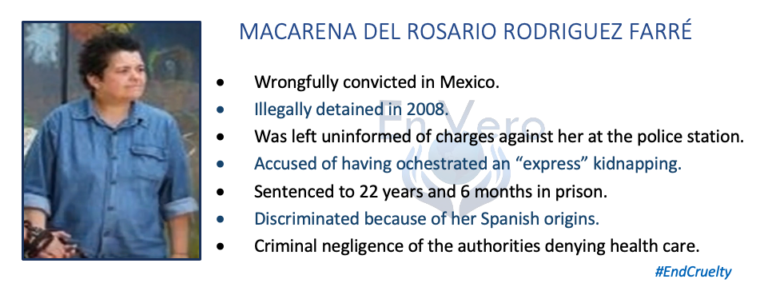Source: Proceso
Author: Ricardo Raphael
June 27, 2020 (Original publication in Spanish on December 15, 2019)
Translation: Emily Freele
Wallace: Gualberto Ramírez’s Accomplice
In June 2014, the journalist Anabel Hernández was denounced by Isabel Miranda de Wallace before the SIEDO (Assistant Attorney General’s Office for Special Investigations on Organized Crime), whose head at that time was Rodrigo Archundia Barrientos. She was accused of allegedly falsifying documents, committing acts against the justice system, threats and also defamation.
The allegation was as ridiculous as it was far-fetched: there is no similar precedent where a journalist has been accused of complicity with organized crime by the Attorney General’s Office (Procuraduría General de la República or PGR ) due to her work.
On May 31, 2014, Anabel Hernández published (Proceso 1960) a series of documents that suggested the existence of at least two official identities for the missing son of Isabel Miranda de Wallace. The alleged victim had a couple of birth certificates and two CURPs (Unique Population Registry Codes).
Five years later, the version exposed by Ms. Hernández has been confirmed. Today there is laboratory evidence that proves from a genetic standpoint that Hugo Alberto Wallace Miranda is in fact the son of Carlos León Miranda.
This data coincides with the birth certificate of Hugo Alberto that was registered in 1970 by his parents, using their surnames.
Ms. Hernández’s report was the first to truly expose the fabrications of the Wallace case. It is therefore understandable that, at the time, Isabel Miranda did everything in her power to derail the journalist’s investigations. This involved utilizing her enormous influence on the Deputy Attorney General Archundia and on the anti-kidnapping unit affiliated with the SIEDO, whose head was Gualberto Ramírez Gutiérrez.
To fabricate the lawsuit against Anabel Hernández, the public prosecutors committed arbitrary and illegal acts that today are worth recounting:
The first victim of this particular fabrication was Giel Meza, a human rights lawyer who is now associated with En Vero, a Canadian organization that has been assisting the victims of the Wallace case.
On Sunday, July 13, 2014, Giel Meza was kidnapped near his home by two men and two women. They shoved him into a vehicle that had no lettering or official license plates and then drove him to the SIEDO office located in the Republic Square (plaza de la República).
When he arrived at that address, his kidnappers identified themselves as PGR officers and informed him that he was being transferred as a detainee due to a lawsuit filed against him concerning the investigation of the Wallace case.
However, as soon as he crossed the threshold of the building, his status changed. The head of the unit, Gualberto Ramírez, informed him that he was in fact there as a witness.
Giel Meza, who has a degree in law, demanded an explanation. Why had he been “picked up” without an arrest warrant? And if he had been taken to the SIEDO as a witness, why was he being treated as if he were a criminal?
In response, Gualberto Ramírez sent attorney Meza to the SIEDO basement so that a doctor could confirm his good health; that is, to certify that the kidnapping officers had not harmed him.
Then, for more than six hours, Meza was interrogated inside a room crowded with officers. He says he had never been so afraid in his life.
The officers wanted to know if he had provided documents regarding the identity of Mrs. Wallace’s son. They also inquired about other individuals who may have provided the journalist with the published material.
After a grueling interrogation, Meza was released. Even today, the lawyer remembers Gualberto Ramírez’s infuriated cries, accusing him of obstructing a very important investigation by the PGR.
Days later, the same operation was repeated, but this time against Enriqueta Cruz, whose daughter, Brenda Quevedo Cruz, is a young woman accused of a very unlikely kidnapping and murder.
Enriqueta Cruz is a woman who is over 60 years old and yet she did not receive any respect from the anti-kidnapping czar. She was taken to the SIEDO by officers who arbitrarily took her to the same basement where Giel Meza had been before.
There, they stripped her naked, humiliated her and let her know that the authorities could do whatever they wanted with her and her body.
Vulnerable after that unpleasant experience, Enriqueta visited Gualberto Ramírez Gutiérrez’s office. There she had to listen to the officer’s shouting.
Ramírez warned her that Mrs. Wallace was a friend of the house and reprimanded her for trying to derail the investigation of the Wallace case.
The official wanted to know names: Who had given Anabel Hernández the birth certificates? Who had given her Hugo Alberto’s CURPs?
After many hours of aggression, Enriqueta Cruz was finally released. But the statements obtained by such arbitrary methods were later included in the denunciation with which the PGR wanted to persecute Anabel Hernández. The objective of Archundia and Ramírez, but above all of Isabel Miranda, was to inhibit future inquiries into the Wallace case.
Gualberto Ramírez Gutiérrez, former head of the PGR’s anti-kidnapping unit, is now facing serious accusations stemming from a different case. Ms. Ana Patricia Moller Vuilleumier denounced him and six other public prosecutors for document forgery, evidence simulation, criminal conspiracy, torture and cruel and inhuman treatment.
Based on the testimonies of Giel Meza and Enriqueta Cruz, these accusations become plausible.
A couple of questions are now becoming relevant: How did Isabel Miranda de Wallace obtain so much power as to make the PGR’s anti-kidnapping unit an instrument of her ambitions? What really links her to Rodrigo Archundia Barrientos and Gualberto Ramírez Gutiérrez?




